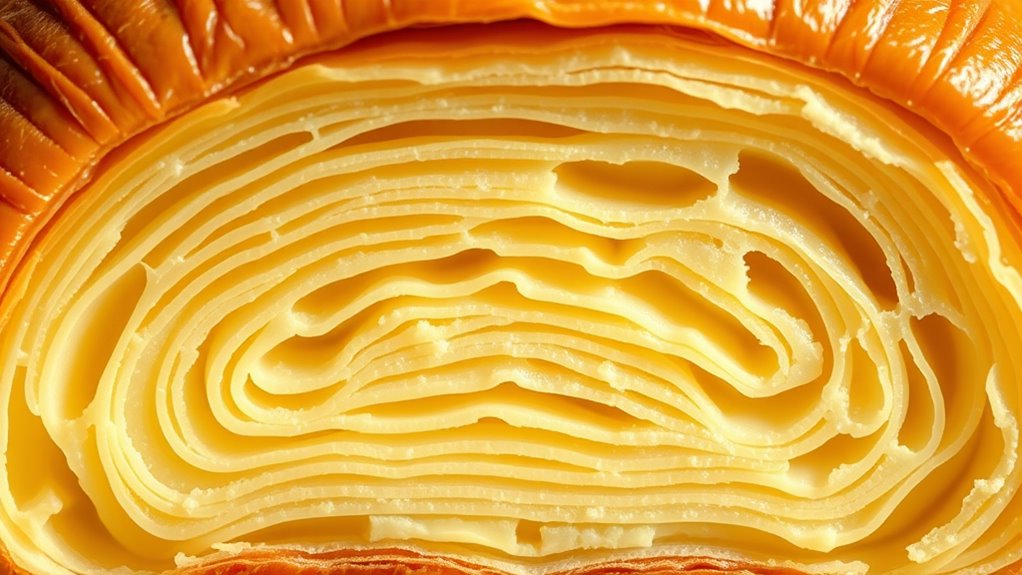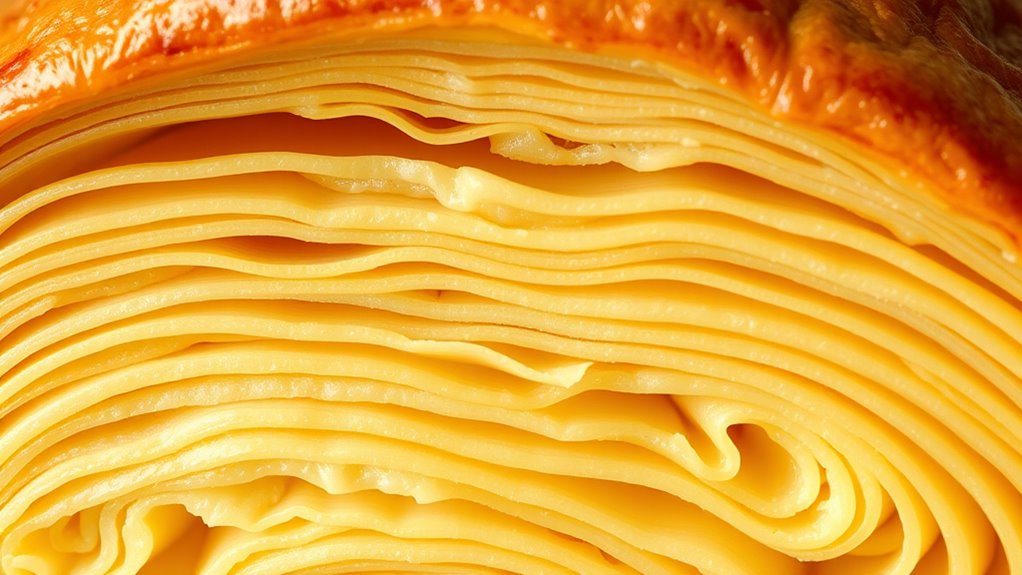To get the maximum layers in your European butter croissant, focus on precise lamination timing by allowing adequate fermentation before rolling and folding. Rest the dough sufficiently between folds to develop gluten and relax the dough, making layering easier. Don’t rush the process—each fold should be done with a chilled, proper-quality butter, and careful resting periods. If you follow these steps, you’ll create flaky, airy layers—continue on to discover how perfect timing truly makes a difference.
Key Takeaways
- Allow adequate fermentation time for dough to develop gluten structure and flavor before lamination.
- Rest the dough sufficiently between folds to enable gluten relaxation and layer formation.
- Perform folds at appropriate intervals, avoiding rushing to maximize layer count and flakiness.
- Use cold, high-quality butter that is firm but pliable to maintain distinct layers during lamination.
- Avoid overworking the dough; gentle handling and proper timing ensure maximum layers and optimal texture.

Have you ever wondered what makes a European butter croissant so irresistibly flaky and rich? It all comes down to the delicate process of lamination, where layers of buttery dough are folded and rolled to create those signature flaky strata. But to achieve the perfect layers, you need to pay close attention to the dough fermentation and butter quality. These two factors are fundamental because they influence how well the dough develops gluten structure and how the butter integrates during lamination, ultimately determining the croissant’s texture and flavor.
Dough fermentation is a critical step that shouldn’t be rushed. When you allow your dough to ferment properly, the yeast produces gases that help the dough rise gradually, developing complex flavors and a tender crumb. Proper fermentation also ensures that the gluten network becomes elastic but not overly tight, which is essential for achieving the right pliability during rolling and folding. If you skip or shorten this step, your dough might be too tight or dense, making it difficult to create thin, even layers. Patience here pays off, as a well-fermented dough will be easier to work with and will produce a croissant with a light, airy interior and crisp exterior. Additionally, understanding the correct fermentation timing can help prevent over-proofing, which can weaken layers and affect texture. Fermentation timing also impacts how well the dough holds its shape during lamination, ensuring even layers and consistent results. Proper fermentation encourages the development of gluten structure, which is vital for the dough’s elasticity and extensibility.
Proper dough fermentation is key for flaky, tender croissants; avoid rushing this essential step.
Equally important is the quality of butter you use. High-quality European butter, with a high fat content and minimal moisture, is key to creating those crisp, flaky layers. Butter with a rich flavor and firm texture allows you to perform the lamination process smoothly, ensuring the layers don’t tear or become greasy. When you incorporate butter into the dough, it should be cold but pliable, allowing you to fold without melting or blending into the dough. This precise temperature control helps maintain distinct layers during baking. Poor-quality or overly soft butter can lead to uneven layers, greasy textures, or a dense crumb. So, investing in good butter is essential for the authentic taste and texture of a European croissant.
Timing during lamination also matters. You want to fold and roll the dough at the right intervals, giving the layers enough time to develop without overworking the dough. This process should be methodical, ensuring each fold contributes to the increasing number of layers—ideally 27 or more—resulting in that signature flaky structure. When the dough is fermented properly and the butter quality is spot-on, the laminating process becomes smoother, and the resulting croissant boasts maximum layers, crispy crust, and tender interior. In the end, mastering timing alongside dough fermentation and butter quality will help you craft croissants that are truly authentic and irresistibly flaky. Focusing on lamination timing can make a significant difference in achieving bakery-quality results at home.
Frequently Asked Questions
Can I Use Margarine Instead of Butter for Lamination?
You can use margarine instead of butter for lamination, but keep in mind margarine qualities vary. Some are softer or contain more water, which can affect layers and flakiness. If you’re seeking vegan alternatives, choose margarine specifically labeled as vegan. These tend to have a more consistent fat content, making them a better substitute. Just guarantee you select a high-quality margarine to achieve the best laminated croissant texture.
How Does Ambient Temperature Affect Lamination and Layering?
Ah, the drama of dough and temperature control—truly a pastry chef’s soap opera. Ambient temperature wildly influences lamination and layering, making your dough more or less cooperative. Hotter temperatures cause butter to soften too quickly, risking loss of layers, while cooler temps help maintain dough consistency. To master your layers, keep the environment steady, control your workspace, and resist the urge to panic—your croissants depend on it.
What Are Common Mistakes That Ruin Lamination Results?
You should avoid common mistakes that ruin lamination results, like overworking the dough, which can develop too much gluten and make layers tough. Also, uneven rolling creates inconsistent layers, leading to uneven puffiness. To get perfect lamination, handle the dough gently, keep it evenly rolled, and don’t rush the process. These steps help maintain the delicate layers and achieve that flaky, airy croissant texture you want.
How Long Can Laminated Dough Be Refrigerated Before Baking?
You can refrigerate laminated dough for up to 24-48 hours to preserve its quality. Proper dough preservation involves wrapping it tightly and keeping it cold, ensuring it doesn’t dry out or ferment prematurely. During refrigeration, the dough’s layers firm up, making it easier to handle and shape. Remember, extending refrigeration beyond this window can compromise texture and rise, so aim to bake within this ideal timeframe for best results.
Is There a Difference in Lamination Technique for Vegan Croissants?
You might wonder if lamination changes for vegan croissants. Yes, it does. Instead of traditional butter, you use vegan butter or alternative fats, which can be softer or more prone to melting. You should chill the dough thoroughly and handle it gently to maintain layers. Laminating with vegan butter requires attention to temperature to prevent melting, ensuring you get those crisp, flaky layers just like classic croissants.
Conclusion
Mastering lamination timing turns your croissant into a golden sunrise, each flaky layer a promise of perfection. When you carefully time your folds, you’re weaving a delicate tapestry of butter and dough, creating a symphony of crispness and tenderness. Think of it as conducting a culinary orchestra—patience and precision bring harmony to every bite. So, trust the process, and soon you’ll savor a croissant that rises like a dream, layered with buttery brilliance.










